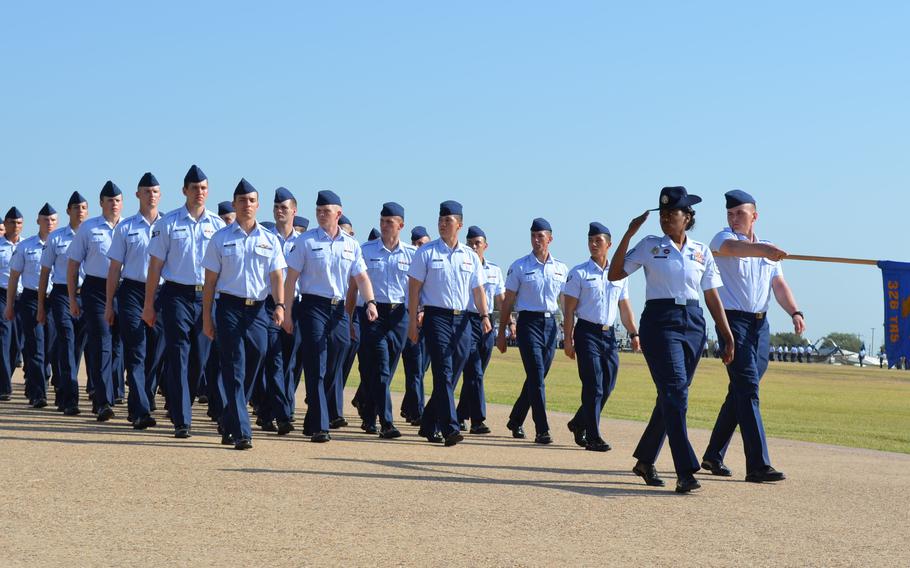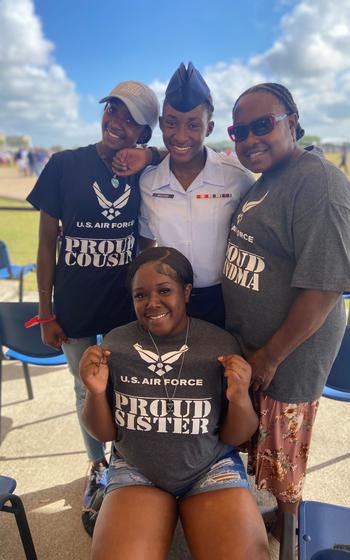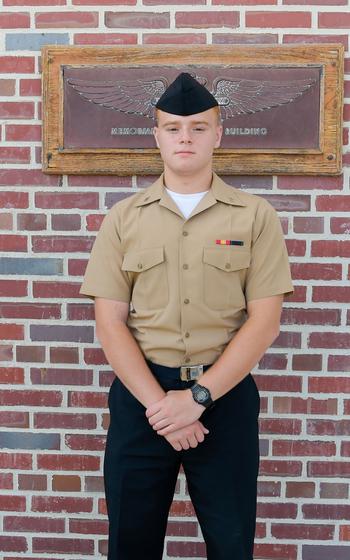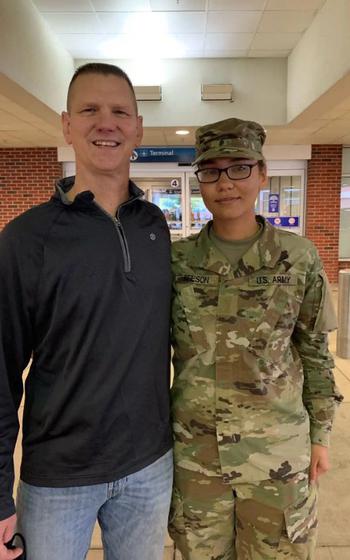
New airmen march during Air Force basic military training graduation June 23 at Joint Base San Antonio-Lackland Air Force Base in Texas. The service said it will meet its recruiting goal for 2022, but will start the next year with a smaller wait list to get a spot at boot camp. (Rose L. Thayer/Stars and Stripes)
Zshanderia Bratcher decided in her freshman year of high school that she would join the military.
By the time she was a senior in Memphis, Tenn., she knew her choice would be the Air Force. Now just months after graduation, the 17-year-old has already finished basic, earned the rank of airman and begun training to join the service’s security forces.
“I wanted to be a part of a cause bigger than myself. I want to make an impact on the world. I thought there's no other place that I could do it better than to join the military, specifically the Air Force,” Bratcher said.
That’s not always the case for young Americans finishing school and shopping for a career. The Air Force, Navy, Marine Corps and Army are struggling this year to find enough recruits.

Airman Zshanderia Bratcher, 17, graduated Air Force basic military training in July surrounded by her family, who traveled from Memphis, Tenn. Bratcher said she was surprised to learn about the difficulty the military has faced recruiting this year, because about 10 of her classmates also chose the military after high school. (Zshanderia Bratcher)
With just over a month left in the fiscal year, the Army, the largest service, expects to reach only 52% of its recruiting goal for a shortfall of 12,000 to 15,000 recruits.
The Air Force, Navy and Marines say they expect to meet their targets but describe this fiscal year, which ends Sept. 30, as among the most difficult since the end of the draft in 1973.
“We're going to make (the) goal” of 26,151 recruits, said Col. Jason Scott, vice commander of Air Force Recruiting Service. “We're going to land on fumes, though.”
The Navy wouldn’t say how close it is to its target of 33,400 active-duty recruits, and the Marines said its figures would not be available until the fiscal year ends.
Only the small, competitive Space Force, which needed fewer than 500 recruits this fiscal year, faces no major recruiting challenges, Scott said.
‘Uncharted territory’
“It’s just really hard to recruit people right now,” said Jeff Wenger, a senior policy researcher with the Rand Corp., who focuses on Army recruiting. “We’re really in uncharted territory here. … It’s hard to make predictions in this market as to what a return to normalcy will be.”
The main challenge is the combination of low unemployment — about 3.5% — and the ease of finding private sector jobs, he said. Last month, civilian employers added 528,000 jobs, according to the Bureau of Labor Statistics.
The military traditionally struggles with recruiting when unemployment is low, but new generational challenges have emerged.
An estimated 71% of young Americans are unfit for military service, according to the Centers for Disease Control and Prevention. The major reasons are obesity, education deficits, criminal records and drug use.
In hopes of addressing the problems, the Army has begun pilot programs to offer pre-basic training camps, one to improve physical fitness and another to boost scores on the Armed Services Vocational Aptitude Battery, or ASVAB, qualification test.
First, however, the service must get young people interested enough to volunteer.
Each service has pulled all the tools out of the box to entice people to sign up. The Army and Navy have relaxed policies on tattoos, allowing for visible ink not previously permitted. For a brief time in June, the Army even lifted the need for a high school diploma, though the change was rescinded within a week.
“There are ways that we are trying to be more attractive to young people,” Adm. Mike Gilday, chief of naval operations, told reporters July 26. “They’re less interested in health care plans. And they’re somewhat interested in education plans, but we’re in a competitive environment with respect to education plans because you can work for Starbucks or McDonald’s and they have education plans as well.”
Bonuses topping $100,000
The Army, Navy and Air Force are offering bonuses for those recruits willing to ship out on short notice or before the end of September.
For the first time in 10 years, the Air Force has twice increased the amount of money available for new recruits with a total of $38.5 million on the table. As of July 31, the Air Force quick-ship bonus of $8,000 has been used 243 times, Scott said.
“I think that’s been an effective recruiting tool,” he said. “Our mission is to ship to [basic military training], and if we have any jobs unfilled within five days, we really focus in on those, and that $8,000 bonus has helped.”
The Navy also announced in August that it will pay off up to $65,000 of student debt for recruits, even those who have prior service in the Navy or another branch. When combined with the maximum quick-ship bonus, a new sailor could pull in $115,000 in enlistment incentives.
“We recognize that we are in a very challenging recruiting environment, in competition with our fellow services and the private sector for the top talent we need to serve as the next generation of Navy leaders and warfighters,” said Cmdr. David Benham, spokesman for Navy Recruiting Command. “While service is not just about the money, we feel these bonuses, taken with existing Navy benefits … will give us an advantage in recruiting top talent to lead us forward.”

Seaman Apprentice Jakob Beronich, 20, graduated from the Navy’s basic training in January, and will finish the remainder of his training in November to begin his career as a cryptologic technician networks in Suffolk, Va. He chose the Navy because it allowed for him to receive advanced cybersecurity job training without going into debt for college. (Kurt Van Slooten)
Seaman Apprentice Jakob Beronich, 20, graduated from the Navy’s basic training in January, shipping out before the big bonuses became available.
However, he did get a $5,000 bonus for selecting the job of cryptologic technician networks, the Navy’s experts in communication defense and forensics.
He said he was drawn to the advanced job training the field required, which can get him a start in the cybersecurity industry without going into debt for college.
“I think when people think about the Navy, they think of the cartoonish grunt working on the deck of a ship, but there's a lot of very advanced technical positions here in the Navy,” said Beronich, who recently completed his apprentice school at the Information Warfare Training Command Corry Station at Naval Air Station Pensacola in Florida.
“So far, I've learned how to program, I've learned how to defend networks, how to exploit networks, I've learned how computers work and function. It's a very surprising level of education I received so far.”
The Navy and Army did not provide information on how popular their bonuses have been, but Rand’s Wenger said they are historically successful in getting people in the door. Even with the bonuses, he said the biggest hurdle is reaching those people who aren’t already thinking about the military, but aren’t immediately opposed to it.
“If you're only targeting the people who are inclined, you're not going to get [to the goal]. You've got to go after people who are not inclined, because they're the larger share,” Wenger said.
That is where on-the-ground recruiters and advertising have saved the Army in a tough year, he said.
“We want our recruiters to get to people who are sort of inclined, who are not just shutting the door immediately and then just need a little bit more information,” Wenger said. “They can learn about the pay, they can learn about the benefits, they can learn about the types of occupations that are available. And when they get all that information, then they feel more comfortable making the decision to join.”
Community connections
Scott said Air Force recruiters have been instrumental in the service meeting its goal, but the pandemic is still taking a toll on their effectiveness. About 70% of recruiters came into the job during the pandemic and missed out on some of the vital in-person training of their predecessors.
“We want to continue that push to make sure that we're making those connections in the community and in the high schools with the influencers,” he said.
Gen. James McConville, the Army’s chief of staff, told reporters July 28 that the service is trying to get its recruiters out to people who don’t have an example of military service in their life, such as a relative.
“I think we need to do a better job of exposing American kids to what the military is all about,” he said. “What we're finding is, when people are exposed, they tend to want to join.”
Of those who join the Army, he said 83% come from a military family and 44% come from a high school that has a Junior Reserve Officer Training Command program.
“We’ve asked our division commanders to partner with our recruiting brigade commanders, so if someone wants to see what a soldier's life looks like, they can come in and do that,” McConville said.
Command Sgt. Maj. Scott Beeson, the senior noncommissioned officer at the Army’s Center for Initial Military Training at Joint Base Langley-Eustis, Va., said when he does this type of outreach, he tries to bring young soldiers out to meet people.
“We’re like dads and grandpas to these kids,” he said. “What we say doesn't resonate as much.”

Command Sgt. Maj. Scott Beeson, seen with his daughter Pvt. Montana Beeson, said he never pushed military service on his five children, but he is proud that they all chose to enlist. About 83% of Army recruits come from military families, but the service is trying to reach beyond that as it is expected to miss its recruiting goal for this year. (Beeson family)
His daughter, Pvt. Montana Beeson, agreed. The 23-year-old is the last of the five Beeson children to join the military and is now acclimating to her first duty station — Fort Campbell, Ky. She said it wasn’t her father’s 34 years of Army service that showed her that a military career could be for her, but rather knowing her mother served for a decade and watching her three sisters choose to enlist.
“I feel like I can relate to them more. Maybe it's a female thing or maybe it’s because as my sisters were in, I could actually watch them progress and go up in rank and study for boards. I could actually view that,” Montana Beeson said.
It was her dad, however, who helped her get in shape and ready for boot camp. Montana Beeson said she was always the one who would choose to stay home while the rest of her family enjoyed going on runs together.
“She busted her butt to get in the military,” Scott Beeson said. “For probably a year prior to her coming in, we did [physical training] together every single day. It was a true bonding event to get her ready to come in the Army.”
No relief in sight
Moving into the new fiscal year, which begins Oct. 1, Wenger said it’s difficult to say whether the military will get any relief from recruiting challenges. He doesn’t see anything that’s going to change in the economy in a way that would impact prospective recruits’ options outside the military.
Wenger said he does worry that incentivizing so many recruits to ship before the end of this fiscal year could leave a deficit going into the next one. Typically, the services like to keep about 20% of their overall goal in what’s called a delayed entry pool.
Scott said he worries about that, too. Typically, the Air Force ends the year with about 25% of the next year’s goal already in its recruiting bank, waiting for an open seat at boot camp. Going into fiscal year 2023, he expects the bank of recruits to only be about 10%.
“We watch how many we add to our qualified and waiting lists, [those] waiting to book a job and go into the bank, and we've just seen a reduction each month,” he said. “We just have [fewer] qualified recruits coming in.”
To counter that drop, the Air Force is focusing on increasing training for recruiters and getting them out there to meet influencers — the community members who help young people decide career goals.
“We want our recruiters out there. We want them educating and promoting Air Force opportunities, especially to those that weren't aware of what service could be,” Scott said.
Bratcher, the newly pinned airman, said she has heard the misconceptions that her peers have of military service. Instead of listening, she said she trusted her recruiter, educated herself with just about every Air Force video that she could find online and went for her dream.
“It’s not all, you’re going to go to war. They’re stuck on a connotation of worrying about dying,” Bratcher said. “That comes as a part of it, but there’s so much more that it has to offer.”